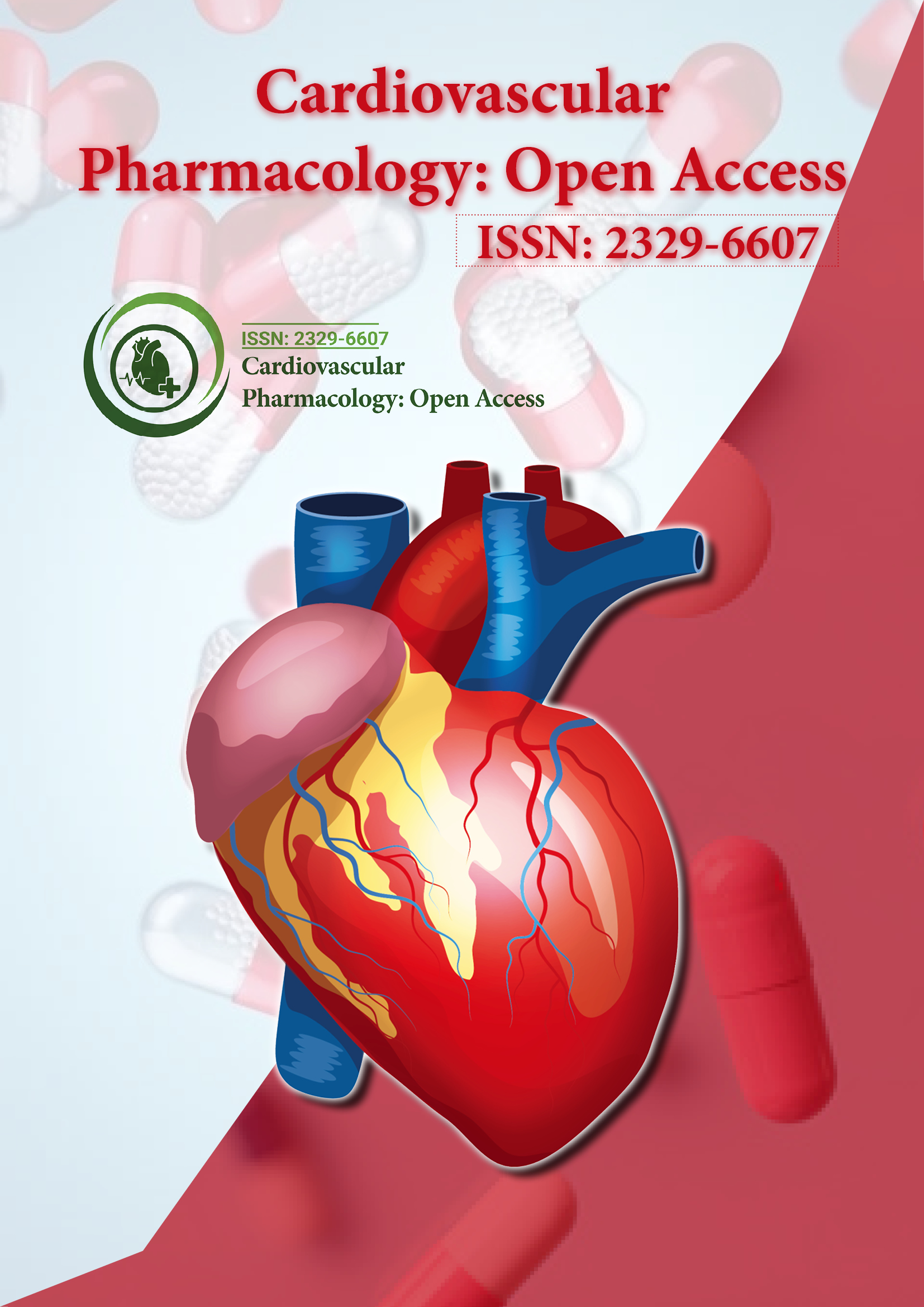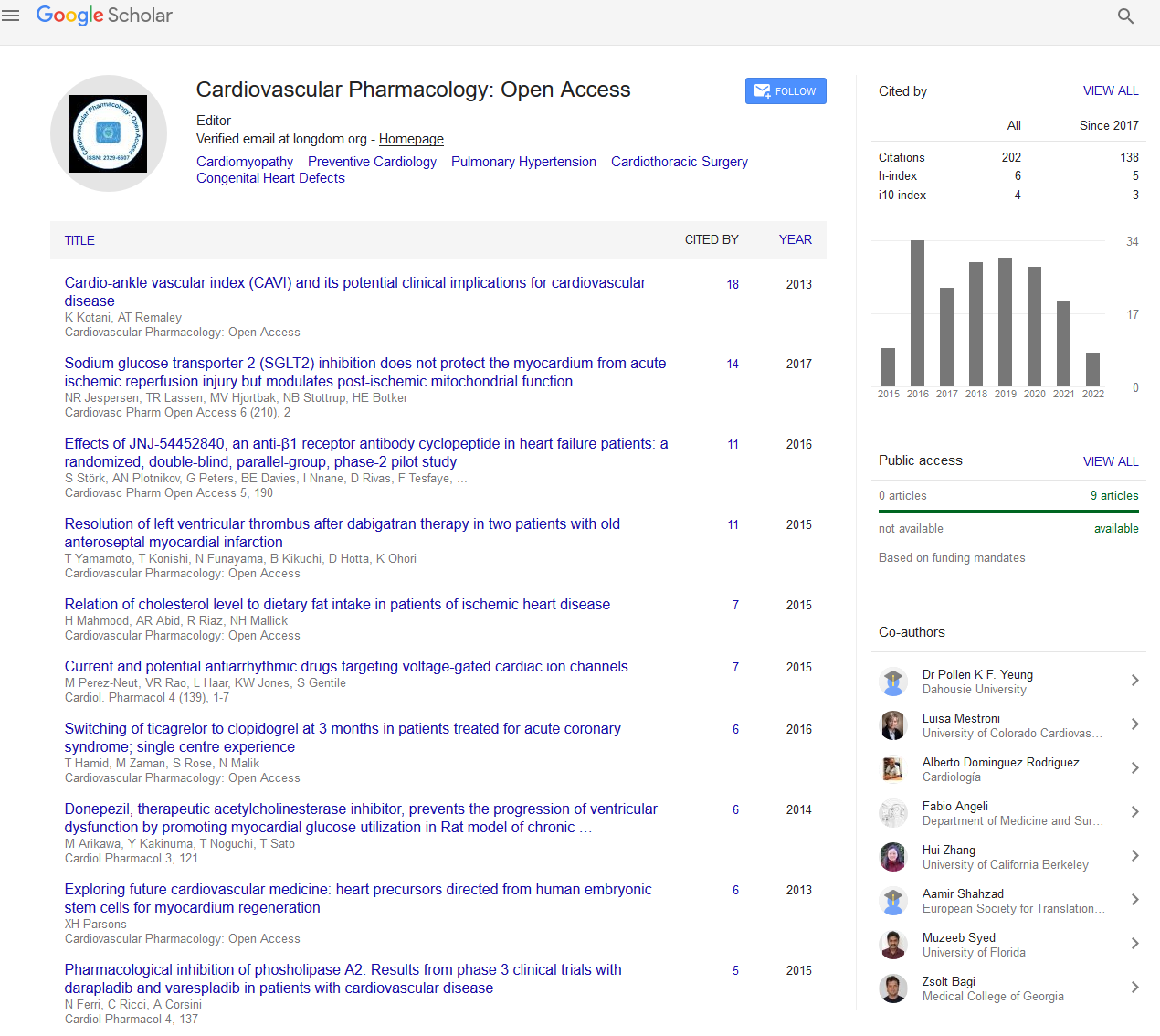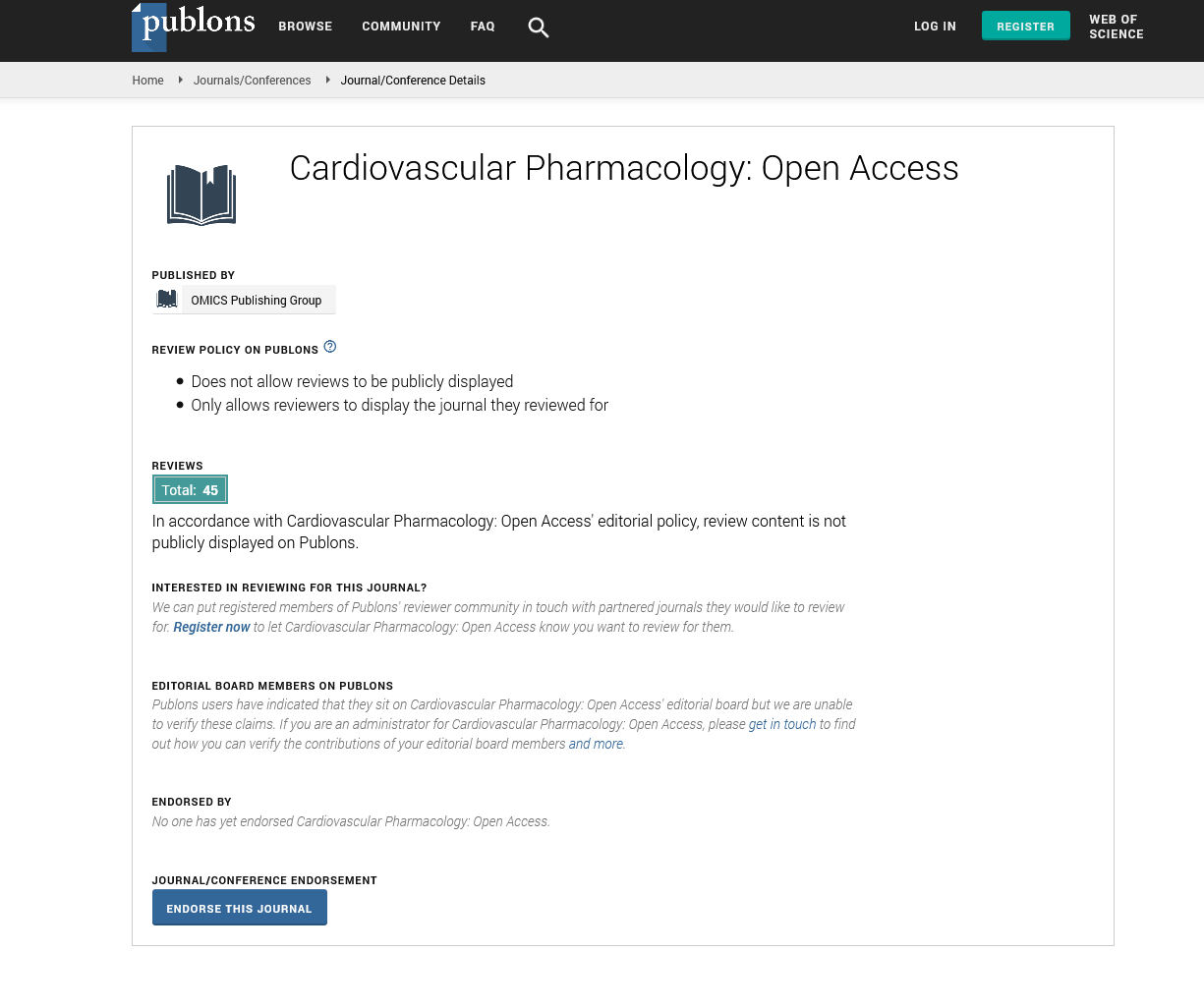Indexed In
- Open J Gate
- Cosmos IF
- RefSeek
- Hamdard University
- EBSCO A-Z
- OCLC- WorldCat
- Publons
- Geneva Foundation for Medical Education and Research
- Euro Pub
- Google Scholar
Useful Links
Share This Page
Journal Flyer

Open Access Journals
- Agri and Aquaculture
- Biochemistry
- Bioinformatics & Systems Biology
- Business & Management
- Chemistry
- Clinical Sciences
- Engineering
- Food & Nutrition
- General Science
- Genetics & Molecular Biology
- Immunology & Microbiology
- Medical Sciences
- Neuroscience & Psychology
- Nursing & Health Care
- Pharmaceutical Sciences
Short Communication - (2024) Volume 13, Issue 4
Pharmacological Interventions for Pediatric Heart Diseases: Insights and Innovations
Richard Wilson*Received: 25-Nov-2024, Manuscript No. CPO-24-28342; Editor assigned: 27-Nov-2024, Pre QC No. CPO-24-28342 (PQ); Reviewed: 12-Dec-2024, QC No. CPO-24-28342; Revised: 20-Dec-2024, Manuscript No. CPO-24-28342 (R); Published: 27-Dec-2024, DOI: 10.35248/2329-6607.24.13.412
Description
Cardiovascular diseases in children are rare but can be severe and life-threatening. These conditions encompass a range of congenital and acquired heart issues that require specialized treatment. Pediatric cardiovascular drug therapy plays an important role in managing these diseases and improving patient outcomes. However, administering drug therapy to children presents unique challenges because of the physiological differences between children and adults. Children's bodies are still developing, meaning drugs may behave differently and requiring careful dosing and consideration [1-3].
Pediatric cardiovascular diseases can be divided into congenital and acquired categories. Congenital heart defects, such as ventricular septal defects, atrial septal defects and tetralogy of Fallot, are present from birth and often require early intervention. Acquired conditions like Kawasaki disease, hypertension and arrhythmias also occur in children [4-6]. These conditions can lead to complications such as heart failure, arrhythmias, or stroke, making pharmacological treatment necessary.
The primary goals of cardiovascular drug therapy in pediatric patients are to control symptoms, prevent complications and improve overall heart function. Medications are used to stabilize hemodynamics, manage arrhythmias, reduce myocardial oxygen demand and prevent thromboembolic events. In some cases, drug therapy serves as a bridge to more definitive treatments, such as surgery or heart transplantation. The choice of drugs depends on the specific condition being treated and the patient’s age, weight and overall health.
Several classes of drugs are commonly used in pediatric cardiovascular care, each targeting specific mechanisms of disease. Diuretics, such as furosemide and hydrochlorothiazide, are prescribed to reduce fluid retention, which is a common complication of heart failure. These medications help reduce blood pressure and improve breathing by decreasing fluid volume in the body. Angiotensin-Converting Enzyme (ACE) inhibitors like enalapril and captopril are used in children with heart failure or hypertension. They work by relaxing blood vessels, reducing the heart’s workload and improving blood flow. Beta-blockers, such as propranolol and atenolol, are frequently used to manage arrhythmias and reduce the risk of sudden cardiac death in pediatric patients [7-10]. These medications lower heart rate and decrease the force of heart contractions, making them particularly useful for conditions like hypertrophic cardiomyopathy and Long QT syndrome (LQTS).
Anticoagulants and antiplatelet drugs, such as heparin, warfarin and aspirin, are used in children who are at an increased risk of blood clots due to congenital heart defects or recent surgery. These medications help prevent thromboembolic events that could lead to stroke or other complications. Digoxin is another commonly used drug, particularly for children with heart failure caused by congenital defects. It increases the force of heart contractions and helps improve cardiac output. Calcium channel blockers, including diltiazem and verapamil, are prescribed for children with supraventricular tachycardia or hypertension. These drugs help control the heart rate and lower blood pressure.
While drugs like statins are less commonly used in children, they may be prescribed for children with familial hypercholesterolemia or other lipid disorders to reduce cholesterol levels and prevent the early onset of cardiovascular diseases. However, using medications in children requires careful consideration of their developmental stage. The pediatric population, especially infants and young children, metabolizes drugs differently, which means dosages must be adjusted based on the child’s age, weight and growth stage. In many cases, cardiovascular drugs are used off-label in children, as clinical trials specifically involving children are limited. This requires close monitoring by healthcare providers to ensure safe and effective use.
In conclusion, pediatric cardiovascular drug therapy is an essential part of managing heart disease in children. Medications such as diuretics, ACE inhibitors, beta-blockers, anticoagulants and digoxin are frequently used to treat various cardiovascular conditions. However, due to the unique physiological characteristics of children, careful dosing and monitoring are essential to ensure safety and efficacy. Although pediatric drug therapy for cardiovascular diseases is improving, more research and data specific to this population are needed to optimize treatment options and enhance the care of young patients with heart conditions.
References
- Genovesi S, Giussani M, Orlando A, Battaglino MG, Nava E, Parati G. Prevention of cardiovascular diseases in children and adolescents. High Blood Press Cardiovasc Prev. 2019;26:191-197.
[Crossref] [Google Scholar] [PubMed]
- Mitsnefes MM. Cardiovascular disease in children with chronic kidney disease. J Am Soc Nephrol. 2012;23(4):578-585.
- Lambert EC, Menon VA, Wagner HR, Vlad P. Sudden unexpected death from cardiovascular disease in children: a cooperative international study. Am J Cardiol. 1974;34(1):89-96.
[Crossref] [Google Scholar] [PubMed]
- Lenfant C. Report of the task force on research in pediatric cardiovascular disease. Circulation. 2002;106(9):1037-1042.
[Crossref] [Google Scholar] [PubMed]
- Meyer RA, Kaplan S. Noninvasive techniques in pediatric cardiovascular disease. Prog Cardiovasc Dis. 1973;15(4):341-367.
[Crossref] [Google Scholar] [PubMed]
- Rodrigues AN, Abreu GR, Resende RS, Goncalves WL, Gouvea SA. Cardiovascular risk factor investigation: a pediatric issue. Int J Gen Med. 2013;6:57-66.
[Crossref] [Google Scholar] [PubMed]
- Hanafy S, Pinsk M, Jamali F. Effect of obesity on response to cardiovascular drugs in pediatric patients with renal disease. Pediatr Nephrol. 2009;24(4):815-821.
[Crossref] [Google Scholar] [PubMed]
- Visscher H, Amstutz U, Sistonen J, Ross CJ, Hayden MR, Carleton BC. Pharmacogenomics of cardiovascular drugs and adverse effects in pediatrics. J Cardiovasc Pharmacol. 2011;58(3):228-239.
[Crossref] [Google Scholar] [PubMed]
- Watt K, Li JS, Benjamin Jr DK, Cohen-Wolkowiez M. Pediatric cardiovascular drug dosing in critically ill children and extracorporeal membrane oxygenation. J Cardiovasc Pharmacol. 2011;58(2):126-132.
[Crossref] [Google Scholar] [PubMed]
- Hausner E, Fiszman ML, Hanig J, Harlow P, Zornberg G, Sobel S. Long-term consequences of drugs on the paediatric cardiovascular system. Drug Saf. 2008;31:1083-1096.
[Crossref] [Google Scholar] [PubMed]
Citation: Wilson R (2024). Pharmacological Interventions for Pediatric Heart Diseases: Insights and Innovations. Cardiovasc Pharm. 13:412.
Copyright: © 2024 Wilson R. This is an open-access article distributed under the terms of the Creative Commons Attribution License, which permits unrestricted use, distribution and reproduction in any medium, provided the original author and source are credited.


